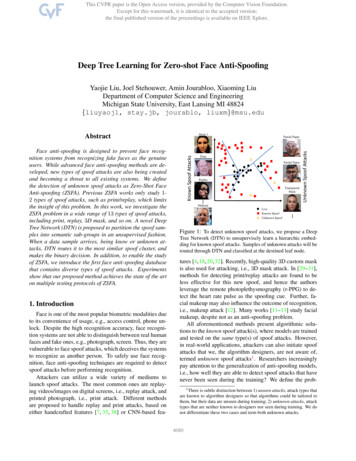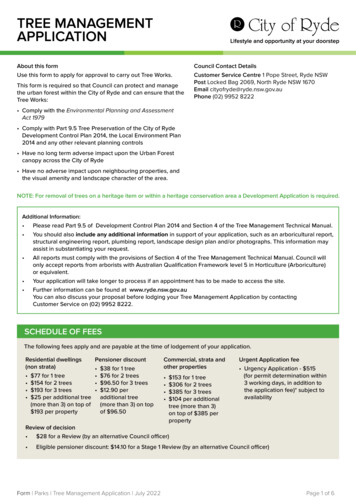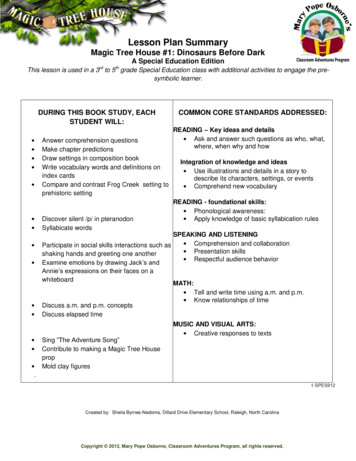
Transcription
Deep Tree Learning for Zero-shot Face Anti-SpoofingYaojie Liu, Joel Stehouwer, Amin Jourabloo, Xiaoming LiuDepartment of Computer Science and EngineeringMichigan State University, East Lansing MI 48824{liuyaoj1, stay.jb, jourablo, liuxm}@msu.eduMask 11. IntroductionFace is one of the most popular biometric modalities dueto its convenience of usage, e.g., access control, phone unlock. Despite the high recognition accuracy, face recognition systems are not able to distinguish between real humanfaces and fake ones, e.g., photograph, screen. Thus, they arevulnerable to face spoof attacks, which deceives the systemsto recognize as another person. To safely use face recognition, face anti-spoofing techniques are required to detectspoof attacks before performing recognition.Attackers can utilize a wide variety of mediums tolaunch spoof attacks. The most common ones are replaying videos/images on digital screens, i.e., replay attack, andprinted photograph, i.e., print attack. Different methodsare proposed to handle replay and print attacks, based oneither handcrafted features [7, 35, 38] or CNN-based fea-PrintPartial PaperReplay TransparentMaskUnknown Spoof AttacksPartial PaperMakeupLiveKnown SpoofUnknown Spoof Face anti-spoofing is designed to prevent face recognition systems from recognizing fake faces as the genuineusers. While advanced face anti-spoofing methods are developed, new types of spoof attacks are also being createdand becoming a threat to all existing systems. We definethe detection of unknown spoof attacks as Zero-Shot FaceAnti-spoofing (ZSFA). Previous ZSFA works only study 12 types of spoof attacks, such as print/replay, which limitsthe insight of this problem. In this work, we investigate theZSFA problem in a wide range of 13 types of spoof attacks,including print, replay, 3D mask, and so on. A novel DeepTree Network (DTN) is proposed to partition the spoof samples into semantic sub-groups in an unsupervised fashion.When a data sample arrives, being know or unknown attacks, DTN routes it to the most similar spoof cluster, andmakes the binary decision. In addition, to enable the studyof ZSFA, we introduce the first face anti-spoofing databasethat contains diverse types of spoof attacks. Experimentsshow that our proposed method achieves the state of the arton multiple testing protocols of ZSFA.Known Spoof AttacksAbstractFigure 1: To detect unknown spoof attacks, we propose a DeepTree Network (DTN) to unsupervisely learn a hierarchic embedding for known spoof attacks. Samples of unknown attacks will berouted through DTN and classified at the destined leaf node.tures [4,18,20,32]. Recently, high-quality 3D custom maskis also used for attacking, i.e., 3D mask attack. In [29–31],methods for detecting print/replay attacks are found to beless effective for this new spoof, and hence the authorsleverage the remote photoplethysmography (r-PPG) to detect the heart rate pulse as the spoofing cue. Further, facial makeup may also influence the outcome of recognition,i.e., makeup attack [12]. Many works [11–13] study facialmakeup, despite not as an anti-spoofing problem.All aforementioned methods present algorithmic solutions to the known spoof attack(s), where models are trainedand tested on the same type(s) of spoof attacks. However,in real-world applications, attackers can also initiate spoofattacks that we, the algorithm designers, are not aware of,termed unknown spoof attacks1 . Researchers increasinglypay attention to the generalization of anti-spoofing models,i.e., how well they are able to detect spoof attacks that havenever been seen during the training? We define the prob1 There is subtle distinction between 1) unseen attacks, attack types thatare known to algorithm designers so that algorithms could be tailored tothem, but their data are unseen during training; 2) unknown attacks, attacktypes that are neither known to designers nor seen during training. We donot differentiate these two cases and term both unknown attacks.14680
lem of detecting unknown face spoof attacks as Zero-ShotFace Anti-spoofing (ZSFA). Despite the success of faceanti-spoofing on known attacks, ZSFA, on the other hand,is a new and unsolved challenge to the community.The first attempts on ZSFA are [3, 45]. They addressZSFA between print and replay attacks, and regard it asan outlier detection problem for live faces (a.k.a. real human faces). With handcrafted features, the live faces aremodeled via standard generative models, e.g., GMM, autoencoder. During testing, an unknown attack is detected ifit lies outside the estimated live distribution. These ZSFAworks have three drawbacks:Lacking spoof type variety: Prior models are developedw.r.t. print and replay attacks only. The respective featuredesign may not be applicable to different unknown attacks.No spoof knowledge: Prior models only use live faces,without leveraging the available known spoof data. Whilethe unknown attacks are different, the known spoof attacksmay still provide valuable information to learn the model.Limitation of feature selection: They use handcraftedfeatures such as LBP to represent live faces, which wereshown to be less effective for known spoof detection [27,32, 37, 48]. Recent deep learning models [20, 32] show theadvantage of CNN models for face anti-spoofing.This work aims to address all three drawbacks. Since oneZSFA model may perform differently when the unknownspoof attack is different, it should be evaluated on a widerange of unknown attacks types. In this work, we substantially expand the study of ZSFA from 2 types of spoof attacks to 13 types. Besides print and replay attacks, we include 5 types of 3D mask attacks, 3 types of makeup attacks, and 3 partial attacks. These attacks cover both impersonation spoofing, i.e., attempt to be authenticated as someone else, and obfuscation spoofing, i.e., attempt to cover attacker’s own identity. We collect the first face anti-spoofingdatabase that includes these diverse spoof attacks, termedSpoof in the Wild database with Multiple Attack Types(SiW-M).To tackle the broader ZSFA, we propose a Deep TreeNetwork (DTN). Assuming there are both homogeneousfeatures among different spoof types and distinct featureswithin each spoof type, a tree-like model is well-suited tohandle this case: learning the homogeneous features in theearly tree nodes and distinct features in later tree nodes.Without any auxiliary labels of spoof types, DTN learns topartition data in an unsupervised manner. At each tree node,the partition is performed along the direction of the largestdata variation. In the end, it clusters the data into severalsub-groups at the leaf level, and learns to detect spoof attacks for each sub-group independently, shown in Fig. 1.During the testing, a data sample is routed to the most similar leaf node to produce a binary decision of live vs. spoof.In summary, our contributions in this work include : Conduct an extensive study of zero-shot face antispoofing on 13 different types of spoof attacks; Propose a Deep Tree Network (DTN) to learn featureshierarchically and detect unknown spoof attacks; Collect a new database for ZSFA and achieve the stateof-the-art performance on multiple testing protocols.2. Prior WorkFace Anti-spoofing Image-based face anti-spoofing refersto face anti-spoofing techniques that only take RGB images as input without extra information such as depth orheat. In early years, researchers utilize liveness cues,such as eye blinking and head motion, to detect print attacks [24, 36, 37, 39]. However, when encountering unknown attacks, such as photograh with eye portion cut,and video replay, those methods suffer from a total failure.Later, research move to a more general texture analysis andaddress print and replay attacks. Researchers mainly utilizehandcrafted features, e.g., LBP [7,16,17,35], HoG [25,47],SIFT [38] and SURF [8], with traditional classifiers, e.g.,SVM and LDA, to make a binary decision. Those methodsperform well on the testing data from the same database.However, while changing the testing conditions such aslighting and background, they often have a large performance drop, which can be viewed as an overfitting issue.Moreover, they also show limitations in handling 3D maskattacks, mentioned in [30].To overcome the overfitting issue, researchers make various attempts. Boulkenafet et al. extract the spoofing features in HSV YCbCR space [7]. Works in [2, 5, 6, 18, 46]consider features in the temporal domain. Recent works [2,4] augment the data by using image patches, and fuse thescores from patches to a single decision. For 3D mask attacks, the heart pulse rate is estimated to differentiate 3Dmask from real faces [28, 30]. In the deep learning era, researchers propose several CNN works [4, 18, 20, 27, 32, 37,48] that outperform the traditional methods.Zero-shot learning and unknown spoof attacks Zeroshot object recognition, or more generally, zero-shot learning, aims to recognize objects from unknown classes [40],i.e., object classes unseen in training. The overall idea isto associate the known and unknown classes via a semanticembedding, whose embedding spaces can be attributes [26],word vector [19], text description [49] and human gaze [22].Zero-shot learning for unknown spoof attack, i.e., ZSFA,is a relatively new topic with unique properties. Firstly,unlike zero-shot object recognition, ZSFA emphasizes thedetection of spoof attacks, instead of recognizing specificspoof types. Secondly, unlike generic objects with rich semantic embedding, there is no explicit well-defined semantic embedding for spoof patterns [20]. As elaborated inSec. 1, prior ZSFA works [3,45] only model the live data viahandcrafted features and standard generative models, with4681
Table 1: Comparing our SiW-M with existing face anti-spoofing datasets.DatasetYearCASIA-FASD [50]Replay-Attack [15]HKBU-MARs [30]Oulu-NPU [9]SiW [32]SiW-M201220122016201720182019Num. ofsubj./vid.50/60050/1, 20035/1, 00855/5, 940165/4, 620493/1, 630Face oFrontalNo[ 90 , 90 ]Yes[ 90 , 90 ]Yesseveral drawbacks. In this work, we propose a deep treenetwork to unsupervisely learn the semantic embedding forknown spoof attacks. The partition of the data naturallyassociates certain semantic attributes with the sub-groups.During the testing, the unknown attacks are projected to theembedding to find the closest attributes for spoof detection.Deep tree networks Tree structure is often found helpful in tackling language-related tasks such as parsing andtranslation [14], due to the intrinsic relation of words andsentences. E.g., tree models are applied to joint vision andlanguage problems such as visual question reasoning [10].Tree structure also has the property for learning featureshierarchically. Face alignment works [23, 41] utilize theregression trees to estimate facial landmarks from coarseto fine. Xiong et al. propose a tree CNN to handle thelarge-pose face recognition [44]. In [21], Kaneko et al. propose a GAN with decision trees to learn hierarchically interpretable representations. In our work, we utilize tree networks to learn the latent semantic embedding for ZSFA.Face anti-spoofing databases Given the significanceof a good-quality database, researchers have releasedseveral face anti-spoofing databases, such as CASIAFASD [50], Replay-Attack [15], OULU-NPU [9], andSiW [32] for print/replay attacks, and HKBU-MARs [30]for 3D mask attacks. Early databases such as CASIAFASD and Replay-Attack [50] have limited subject variety,pose/expression/lighting variations, and video resolutions.Recent databases [9, 30, 32] improve those aspects, and alsoset up diverse evaluation protocols. However, up to now, alldatabases focus on either print/replay attacks, or 3D maskattacks. To provide a comprehensive study of face antispoofing, especially the challenging ZSFA, we for the firsttime collect the database with diverse types of spoof attacks,as in Tab. 1. The details of our database are in Sec. 4.3. Deep Tree Network for ZSFAThe main purposes of DTN are twofold: 1) discover thesemantic sub-groups for known spoofs; 2) learn the featuresin a hierarchical way. The architecture of DTN is shown inFig. 2. Each tree node consists of a Convolutional ResidualUnit (CRU) and a Tree Routing Unit (TRU), while the leafnode consists of a CRU and a Supervised Feature Learning(SFL) module. CRU is a block with convolutional layersand the short-cut connection. TRU defines a node routingfunction to route a data sample to one of the child 111Spoof attack types3D mask makeup000020000053partial000003Total num. ofspoof types3222213The routing function partitions all visiting data along thedirection with the largest data variation. SFL module concatenates the classification supervision and the pixel-wisesupervision to learn the spoofing features.3.1. Unsupervised Tree Learning3.1.1Node Routing FunctionFor a TRU node, let’s assume the input x f (I θ) Rmis the vectorized feature response, I is data input, θ is the parameters of the previous CRUs, and S is the set of data samples Ik , k 1, 2, ., K that visit this TRU node. In [44],Xiong et al. define a routing function as:ϕ(x) xT · v τ,(1)where v denotes the projection vector and τ is the bias. DataS can then be split into Slef t : {Ik ϕ(xk ) 0, Ik S} andSright : {Ik ϕ(xk ) 0, Ik S}, and directed to the leftand right child node, respectively. To learn this function,they propose to maximize the distance between the mean ofSlef t and Sright , while keeping the mean of S centered at0. This unsupervised loss is formulated as:( N1L ( N1lPIk Slef tPIk Sϕ(xk ) ϕ(xk ))2P1Nrϕ(xk ))2,(2)Ik Srightwhere N , Nl , Nr denote the number of samples in each set.However, in practice, minizing Equ. 2 might not lead toa satisfactory solution. Firstly, the loss can be minimized byincreasing the norm of either v or x, which is a trivial solution. Secondly, even when the norms of v, x are constrained,Equ. 2 is affected by the density of data S and can be sensitive to the outliers. In other words, the zero expectation ofϕ(x) does not necessarily result in a balanced partition ofdata S. Local minima could be achieved when all data aresplit to one side. In some cases, the tree may suffer fromcollapsing to a few (even one) leaf nodes.To better partition the data, we propose a novel routingfunction and an unsupervised loss. Regardless of τ , the dotproduct between xT and v can be regarded as projecting x tothe direction of v. We design v such that we can observe thelargest variation after projection. Inspired by the conceptof PCA, the optimal solution naturally becomes the largestPCA basis of data S. To achieve this, we first constrain v to4682
256 256 6(RGB LSFLSFLCRUSFLmax poolMℱCRULeaf Node32 32 40SFL(d)(a)4040fcCRUTRUMask Map32 32 1convCRUCRUconv(b)SFLLeafNodes/2fcTRU40Feature convTRUconv)CRU50020/1Figure 2: The proposed Deep Tree Network (DTN) architecture. (a) the overall structure of DTN. A tree node consists of a ConvolutionalResidual Unit (CRU) and a Tree Routing Unit (TRU), and a leaf node consists of a CRU and a Supervised Feature Learning (SFL) module.(b) the concept of Tree Routing Unit (TRU): finding the base with largest variations; (c) the structure of each Convolutional Residual Unit(CRU); (d) the structure of the Supervised Feature Learning (SFL) in the leaf nodes.be norm 1 and reformulate Equ. 1 as:ϕ(x) (x µ)T · v,kvk 1,(3)where µ is the mean of data S. Then, finding v is identicalto finding the largest eigenvector of the covariance matrixTX̄S X̄S , where X̄S XS µ, and XS RN K is the dataTmatrix. Based on the definition of eigen-analysis X̄S X̄S v λv, our optimization aims to maximize:Targ max λ arg max vT X̄S X̄S v.v,θ(4)v,θThe loss for learning the routing function is formulated as:TTLroute exp( αvT X̄S X̄S v) βTr(X̄S X̄S ),(5)where α, β are scalars, and set as 1e-3, 1e-2 in our experiments. We apply the exponential function on the first termto make the maximization problem bounded. The secondterm is introduced as a regularizer to prevent trivial solutions by constraining the trace of covariance matrix of X̄S .3.1.2Tree of Known SpoofsWith the routing function, we can build the entire binarytree. Fig. 2 shows a binary tree of depth of 4, with 8 leafnodes. As mentioned early in Sec. 3, the tree is designedto find the semantic sub-groups from all known spoofs,and is termed as spoof tree. Similarly, we may also trainlive tree with live faces only, as well as general data treewith both live and spoof data. Compared to spoof tree,live and general data tree have some drawbacks. Live treedoes not convey semantic meaning for the spoof, and theattributes learned at each node cannot help to route and better detect spoof; General data tree may result in imbalancedsub-groups, where samples of one class outnumber another.Such imbalance would cause bias for supervised learning inthe next stage.Hence, when we compute Equ. 5 to learn the routingfunctions, we only consider the spoof samples to constructXS . To have a balanced sub-group for each leaf, we suppress the responses of live data to zero, so that all live datacan be evenly partitioned to the child nodes. Meanwhile,we also suppress the responses of the spoof data that do notvisit this node, so that every node models the distribution ofa unique spoof subset.Formally, for each node, we maximize the routing function responses of spoof data that visit this node (denoted asS), while minimizing the responses of other data (denotedas S ), including all live data and spoof data that don’t visitthis node, i.e., that visit neighboring nodes. To achieve thisobjective, we define the following loss:Luniq 1 X Tx̄k vNIk S2 1 Xx̄Tk vN 2.(6)Ik S3.2. Supervised Feature LearningGiven the routing functions, a data sample Ik will be assigned to one of the leaf nodes. Let’s first define the featureoutput of leaf node as F(Ik θ), shortened as Fk for simplicity. At each leaf node, we define two node-wise supervised tasks to learn discriminative features: 1) binary classification drives the learning of a high-level understandingof live vs. spoof faces, 2) pixel-wise mask regression drawsCNN’s attention to low-level local feature learning.Classification supervision To learn a binary classifier, asshown in Fig. 2(d), we apply two additional convolutionlayers and two fully connected layers on Fk to generate afeature vector ck R500 . We supervise the learning via the4683
1 1 conv&(), 16,16,20)(), , ,, -)resize(), , ,, 20)reshape(), 16 16 20)batch normw/o scale(), 16 16 20)( (&)(), 1)#TRUFigure 3: The structure of the Tree Routing Unit (TRU).softmax cross entropy loss:Lclass o1 Xn(1 yk )log(1 pk ) yk logpk (7)NIk Spk exp(w1 T ck ),exp(w0 k ) exp(w1 T ck )Tc(8)where S represents all the data samples that arrive this leafnode, N denotes the number of samples in S, {w0 , w1 } arethe parameters in the last fully connected layer, and yk isthe label of data sample k (1 denotes spoof, and 0 live).Pixel-wise supervision We also concatenate another convolution layer to Fk to generate a map response Mk R32 32 . Inspired by the prior work [32], we leverage thesemantic prior knowledge of face shapes and spoof attackposition to provide a pixel-wise supervision. Using thedense face alignment model [33], we provide a binary maskDk R32 32 , shown in Fig. 4, to indicate the pixels ofspoof mediums. Thus, for a leaf node, the loss function forthe pixel-wise supervision is:Lmask 1 XkMk Dk k1 .N(9)Ik SOverall loss Finally, we apply the supervised losses on pleaf nodes, the unsupervised losses on q TRU nodes, andformulate our training loss as:L pX(α1 Liclass α2 Limask ) i 1qX(α3 Ljroute α4 Ljuniq ),j 1(10)where α1 ,α2 ,α3 ,α4 are the regularization coefficients foreach term, and are set as 0.001, 1.0, 2.0, 0.001 respectively.For a 4-layer DTN, p 8 and q 7.3.3. Network ArchitectureDeep Tree Network (DTN) DTN is the main frameworkof the proposed model. It takes I R256 256 6 as input, where the 6 channels are RGB HSV color spaces. Weconcatenate three 3 3 convolution layers with 40 channels and 1 max-pooling layer, and group them as one Convolutional Residual Unit (CRU). Each convolution layer isequipped with ReLU and group normalization layer [43],due to the dynamic batch size in the network. We also apply a shortcut connection for each convolution layer. Foreach tree node, we deploy one CRU before the TRU. At theleaf node, DTN produces the feature representation of inputI as F(I θ) R32 32 40 , then uses one 1 1 convolutionlayer to generate the binary mask map M.Tree Routing Unit (TRU) TRU is the module routing thedata sample to one of the child CRUs. As shown in Fig. 3,it first compresses the feature by using an 1 1 convolution layer, and resizing the response spatially. For the rootnode, we compress the CRU feature to x R32 32 10 ,and for later tree node, we compress the CRU feature tox R16 16 20 . Compressing the input feature to a smallersize helps to reduce the burden of computating and savingthe covariance matrix in Equ. 5. E.g., the vectorized feature for the first CRU is x R655,360 , and the covariancematrix of x can take 400GB in memory. However, aftercompression the vectorized feature is x R10,240 , and thecovariance matrix of x only needs 0.1GB of memory.After that, we vectorize the output and apply the routingfunction ϕ(x). To compute µ in Equ. 3, instead of optimizing it as a variable of the network, we simply apply abatch normalization layer without scaling to save the moving average of each mini-batch. In the end, we project thecompressed CRU response to the largest basis v and obtainthe projection coefficient. Then we assign the samples withnegative coefficient to the left child CRU and the sampleswith positive coefficient to the right child CRU.Implementation details With the overall loss in Equ. 10,our proposed network is trained in an end-to-end fashion.All losses are computed based on each mini-batch. DTNmodules and TRU modules are optimized alternately. Whileoptimizing DTN, we keep the parameters of TRUs fixed andvice versa.4. Spoof in the Wild Database with MultipleAttack TypesTo benchmark face anti-spoofing methods specificallyfor unknown attacks, we collect the Spoof in the Wilddatabase with Multiple Attack Types (SiW-M). Comparedwith the previous databases in Tab. 1, SiW-M shows a greatdiversity in spoof attacks, subject identities, environmentsand other factors.For spoof data collection, we consider two spoofing scenarios: impersonation, which entails the use of spoof to berecognized as someone else, and obfuscation, which entailsthe use to remove the attacker’s own identity. In total, wecollect 968 videos of 13 types of spoof attacks listed hieratically in Fig 4. For all 5 mask attacks, 3 partial attacks, ob4684
sLive(493 / 660)Replay(21 / 99)Print(60 / 118)Half Mask(12 / 72)Silicone(12 / 27)Transparent(88 / 88)Papercraft(6 / 17)Mannequin(12 / 40)3D Mask AttacksObfuscation(23 / 23)Imperson.(61 / 61)Cosmetic(37 / 50)Funny Eye(160 / 160)Makeup AttacksPaperglasses Partial Paper(122 / 127)(86 / 86)Partial AttacksFigure 4: The examples of the live faces and 13 types of spoof attacks. The second row shows the ground truth masks for the pixel-wisesupervision Dk . For (m, n) in the third row, m/n denotes the number of subjects/videos for each type of data.fuscation makeup and cosmetic makeup, we record 1080PHD videos. For impersonation makeup, we collect 720Pvideos from Youtube due to the lack of special makeupartists. For print and replay attacks, we intend to collectvideos from harder cases where the existing system fails.Hence, we deploy an off-the-shelf face anti-spoofing algorithm [32] and record spoof videos when the algorithm predicts live.For live data, we include 660 videos from 493 subjects.In comparison, the number of subjects in SiW-M is 9 timeslarger than Oulu-NPU [9] and CASIA-FASD [50], and 3times larger than SiW [32]. In addition, subjects are diverse in ethnicity and age. The live videos are collected in3 sessions: 1) a room environment where the subjects arerecorded with few variations such as pose, lighting and expression (PIE). 2) a different and much larger room wherethe subjects are also recorded with PIE variations. 3) amobile phone mode, where the subjects are moving whilethe phone camera is recording. Extreme pose angles andlighting conditions are introduced. Similar to print and replay videos, we deploy the face anti-spoofing algorithm [32]to find out the videos where the algorithm predicts spoof.Hence, this third session is a harder scenario.In total, we collect 1, 630 videos and each lasts 5-7 seconds. The 1080P videos are recorded by Logitech C920 webcam and Canon EOS T6. To use SiW-M for the study ofZSFA, we define the leave-one-out testing protocols. Eachtime we train a model with 12 types of spoof attacks plusthe 80% of the live videos, and test on the left 1 attack typeplus the 20% of live videos. There is no overlapping subjects between the training and testing sets of live videos.5. Experimental Results5.1. Experimental SetupDatabases We evaluate our proposed method on multipledatabases. We deploy the leave-one-out testing protocolson SiW-M and report the results of 13 experiments. Also,we test on previous face anti-spoofing databases, includingCASIA [50], Replay-Attack [15], and MSU-MFSD [42]),compare with the state of the art.Evaluation metrics We evaluate with the followingmetrics: Attack Presentation Classification Error Rate(APCER) [1], Bona Fide Presentation Classification ErrorRate (BPCER) [1], the average of APCER and BPCER,Average Classification Error Rate (ACER) [1], Equal Error Rate (EER), and Area Under Curve (AUC). Note that,in the evaluation of unknown attacks, we assume there is novalidation set to tune the model and thresholds while calculating the metrics. Hence, we determine the threshold basedon the training set and fix it for all testing protocols. A single test sample is one video frame, instead of one video.Parameter setting The proposed method is implementedin Tensorflow, and trained with a constant learning rate of0.001 with a batch size of 32. It takes 15 epochs to converge. We randomly initialize all the weights using a normaldistribution of 0 mean and 0.02 standard deviation.5.2. Experimental Comparison5.2.1 Ablation StudyAll ablation studies use the Funny Eye protocol.Different fusion methods In the proposed model, both thenorm of the mask maps and binary spoof scores could beutilized for the final classification. To find the best fusionmethod, we compute ACER from using map norm, softmaxscore, the maximum of map norm and softmax score, andthe average of two values, and obtain 31.7%, 20.5%, 21.0%,and 19.3% respectively. Since the average score of the masknorm and binary spoof score performs the best, we use itfor the remaining experiments. Moreover, we set 0.2 as thefinal threshold to compute APCER, BPCER and ACER forall the experiments.Different routing methods Routing is a crucial step to findthe best subgroup to detect spoofness of a testing sample.To show the effect of proper routing, we evaluate 2 alternative routing strategies: random routing and pick-one-leaf.Random routing denotes randomly selecting one leaf nodefor a testing sample to produce prediction; Pick-one-leaf denotes constantly selecting one particular leaf node to produce results, for which we report the mean score and standard deviation of 8 selections. Shown in Tab. 3, both strategies perform worse than the proposed routing function. Inaddition, the large standard deviation of pick-one-leaf strategy shows the large performance difference of 8 subgroupson the same type of unknown attacks, and demonstrates thenecessity of a proper routing.4685
Table 2: AUC (%) of the model testing on CASIA, Replay, and MSU-MFSD.MethodsOC-SVMRBF BSIF [3]SVMRBF LBP [9]NN LBP [45]OursVideo70.791.594.290.0CASIA [50]Cut Photo Warped 99.899.9Replay-Attack [15]Digital Photo Printed Photo88.173.798.287.395.278.999.999.6Table 3: Compare models with different routing strategies.StrategiesRandom routingPick-one-leafProposed routing functionAPCER37.151.2 20.017.0BPCER16.118.1 4.921.5ACER26.634.7 .521.55.2.2Testing on existing databasesFollowing the protocol proposed in [3], we use CASIA [50],Replay-Attack [15] and MSU-MFSD [42] to perform ZSFAtesting between replay and print attacks. Tab. 2 comparesthe proposed method with top three methods selected fromover 20 methods in [3, 9, 45]. Our proposed method outperforms the prior state of the art by a convincing margin of7.3%, and our smaller standard deviation further indicates aconsistently good performance among unknown attacks.5.2.3Testing on SiW-MWe execute 13 leave-one-out testing protocols on SiWM. We compare with two of the most recent face antispoofing methods [9,32], and set [32] as the baseline, whichhas demonstrated its SOTA performance on various benchmarks. For a fair comparison with the baseline, we providethe same pixel-wise labeling (as in Fig. 4), and set the sameOverall78.7 11.788.6 16.386.7 15.695.9 6.2N2N3N4EER27.331.244.836.219.8Advantage of each loss function We have three importantdesigns in our unsupervised tree learning: route loss Lroute ,data used to compute the route loss, and the unique lossLuniq . To show the effect of each loss and the training strategy, we train and compare networks with each loss excludedand alternative strategies. First, we train a network with therouting function proposed in [44], and then 4 models withdifferent modules on and off, shown in Tab. 4. The modelwith MPT [44] routes data only to 2
the detection of unknown spoof attacks as Zero-Shot Face Anti-spoofing (ZSFA). Previous ZSFA works only study 1-2 types of spoof attacks, such as print/replay, which limits the insight of this problem. In this work, we investigate the ZSFA problem in a wide range of 13 types of spoof attacks, including print, replay, 3D mask, and so on. A .











